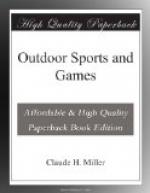The moths are among the most beautiful creatures in nature and a reasonably complete collection of the specimens in your neighbourhood will be something to be proud of.
[Illustration: The Moth Collector and His Outfit (Photograph by F.W. Stack)]
The plant and flower collector should combine his field work with a study of botany. Like most subjects in school books, botany may seem dry and uninteresting but when we learn it for some definite purpose such as knowing the wild flowers and calling them our friends, we must accept the few strange words and dry things in the school work as a little bitter that goes with a great deal of sweet.
A collection of dried plants is called an herbarium. It is customary to take the entire plant as a specimen including the roots. Separate specimens of buds, leaves, flowers and fruit taken at different seasons of the year will make the collection more complete. Specimens should be first pressed or flattened between sheets of blotting paper and then mounted on sheets of white paper either by glue or by strips of gummed paper.
After a flower is properly identified, these sheets should be carefully numbered and labelled and a record kept in a book so that we can readily find a specimen without unnecessarily handling the specimen sheets. The sheets should be kept in heavy envelopes of manila paper and placed in a box just the size to hold them. The standard or museum size of herbarium sheets is 11-1/2 x 16-1/2 inches. Specimens of seaweed or leaves can be kept in blank books.
A typical label for plants or flowers should be as follows:
Common names Yellow adder’s
tongue Date collected, May 16th, 1908
Dog tooth violet
Botanical name Erythronium Americanum REMARKS:
John Burroughs
Family Lilies suggests
that the name
Where found Rockaway Valley near be changed
either to
Beaver Brook fawn lily
because its
leaves
look like a spotted
fawn or
trout lily
because
they always
appear
at trout fishing
season.
A boy or girl living in a section where minerals are plentiful, can make a very interesting collection of stones and mineral substances, especially crystals. This should be taken up in connection with school work in chemistry and mineralogy. To determine the names of minerals is by no means as easy as that of flowers or animals. We shall need to understand something of blow-pipe analysis. As a rule a high school pupil can receive a great deal of valuable instruction and aid from one of his teachers in this work. Mineral specimens should be mounted on small blocks or spindles using sealing wax to hold them in place.
There are unlimited possibilities in nature for making collections. Shells, mosses, ferns, leaves, grasses, seeds, are all interesting and of value. An observation beehive with a glass front which may be darkened will show us the wonderful intelligence of these little creatures. The true spirit of nature study is to learn as much as we can of her in all of her branches, not to make a specialty of one thing to the neglect of the rest and above all not to make work of anything.




